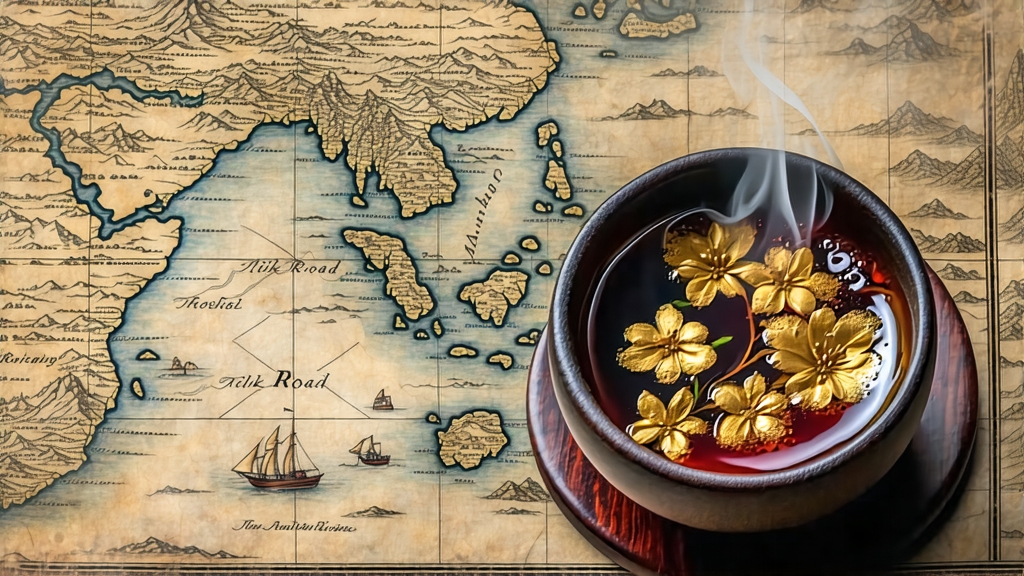
Among the six great families of Chinese tea, dark tea—hei cha—remains the most enigmatic to outsiders. Within this shadowed realm, Fu brick tea from Hunan province stands out like a shard of obsidian flecked with gold. Travelers once carried it across deserts and plateaus, not merely as merchandise but as living currency that improved with every jolt of a camel saddle. Today the same bricks journey by container ship to Brooklyn, Berlin and Brisbane, still quietly breathing through the paper that wraps them.
History: From Frontier Necessity to National Treasure
The story begins in the 1360s, when the Ming court revoked the previous tribute of compressed green tea from Sichuan and demanded a darker, more stable product for the horse-tea trade with Tibet. Caravans needed a tea that would neither mold nor lose flavor during the six-month trek from Chang’an to Lhasa. Tea makers in Anhua county, Hunan, discovered that allowing crude maocha to ferment slightly before re-steaming and compressing it into 2-kilogram bricks solved the problem. The route became known as the “Tea Road,” a southern parallel to the Silk Road, and Fu bricks—named after the government-run “Fu” warehouses—were its black gold. By the Qing dynasty, imperial edicts fixed the weight, size and even the 5 % moisture standard still observed today.
Microbial Alchemy: The Birth of Golden Flowers
What truly distinguishes Fu brick is the deliberate inoculation of Eurotium cristatum, a harmless mold that blooms into tiny yellow spheres called “golden flowers” (jin hua). Far from being spoilage, these flowers are the tea’s signature of quality. During the 28-day “flowering” phase, bricks are stacked in underground cellars at 28 °C and 75 % humidity. Workers turn them every three days so oxygen penetrates evenly; the mold metabolizes polyphenols, converts starches into soluble sugars, and lowers tannic bitterness. The result is a liquor that tastes like buckwheat honey, dried apricot and the faintest whisper of old library leather.
Craft: From Leaf to Loaf
Fu brick production follows a calendar unchanged for three centuries.
- Picking: Only the 3rd and 4th mature leaves plucked after Grain Rain contain enough lignin to feed the fungi.
- Fixing: A 3-minute blast at 280 °C deactivates leaf enzymes but preserves thick-walled structures.
- Rolling: 45 minutes of mechanical twisting ruptures cells without breaking veins, preparing highways for microbes.
- Piling: Seven hours in a cedar-lined room at 50 °C initiates pre-fermentation; the leaf pile smells of cocoa and wet pine.
- Steaming: 90 seconds of 100 °C steam softens the leaf for compression yet keeps surface microbes alive.
- Molding: Tea is tipped into birch-wood boxes lined with cotton paper and pressed under 50-ton hydraulic plates for six minutes, achieving the standard 14 × 9 × 3 cm brick.
- Flowering: Bricks are spaced on bamboo racks, covered with wet hemp cloth, and left to “breathe” for four weeks.
- Drying: A 72-hour desiccation at 40 °C drops moisture to 12 %, locking the golden flowers in suspended animation.
The finished brick is wrapped in rice paper, then kraft, then a final sleeve of bamboo bark—materials chosen because they allow minute gas exchange while repelling moisture. Properly stored, a Fu brick can sail past its fiftieth birthday, its flavor deepening from plum to raisin to date.
Varieties: Beyond the Classic Brick
Although the 2-kg “Qianliang” (Thousand-Tael) log and the 5-kg “Bailiang” share the same leaf base, only bricks of 1–2 kg undergo full flowering. Smaller 100-gram “mini-Fu” bricks developed for urban millennials flower for just 10 days, yielding a lighter cup. A 1990s experiment in Yunnan transplanted the process to large-leaf assamica; the resulting “Dian-Fu” carries camphor notes but rarely achieves the apricot sweetness of Hunan originals.
Brewing: Coaxing the Caravan Memory
Fu brick forgives the inattentive, yet rewards the precise.
Water: Begin with spring water at 100